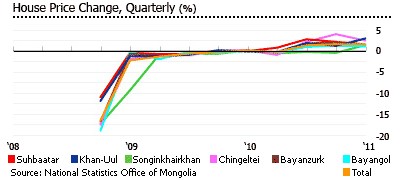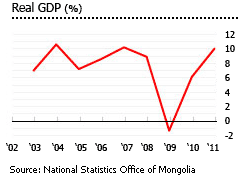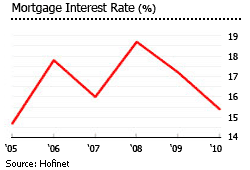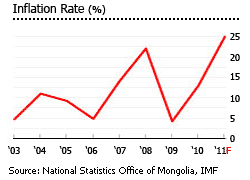Mongolia's housing market recovering

Ulan Bator’s housing index is up! The world’s newest house price index rose 4.46% y-o-y to Q1 2011, though when adjusted for inflation house prices were 3.36% down y-o-y. But in the first quarter of 2011 the index rose by 1.6%, the third quarterly rise since late 2008, when house prices began to fall due to the commodity crisis.
The index, which covers six districts of Ulan Bator, the capital, was first published in the fourth quarter of 2008 by the National Statistics Office of Mongolia.
In the first quarter of 2011 the “average band” of Ulan Bator house prices ranged from MNT850,000 (US$702) per square meter (sq. m.), to MNT1.48 million (US$1,223) per sq. m..
However, luxury apartment prices range from MNT2 million (US$1,653) per sq. m. to MNT10 million (US$8,264) per sq. m.
As the economy returns to double-digit growth, the property market is expected to continue recovering in 2011 and 2012.
Local house price variations
In the prestigious 105m Blue Sky Tower, currently the tallest building in Mongolia, located in the pulsating heart of Ulan Bator, apartments are offered at over MNT9.7 million (US$8,016) per square metre. These are some of the most expensive apartments in the country.

More typical is the Temple View Residence, developed by Mongolian Properties, condominium units are priced at about MNT2.9 million (US$2,400) per sq.m. Prices range from MNT227.48 million (US$188,000) for two-bedroom units, to MNT313.78 million (US$259,322) for three-bedroom units. The building is in the heart of the city, near the Choijin Lama Temple.
At the Royal Green Villa, in Ulan Bator’s posh Zaisan neighborhood, premium apartments sell for not more than MNT484 million (US$400,000).
Prices of luxury apartments at the Olympic Residence, an 18-storey mixed-use development, start at MNT2.78 million (US$2,300) per sq. m.. That is around MNT242 million (US$200,000) per apartment.
Ulan Bator’s most desirable residential buildings/compounds include The Brauhaus, the Temple Residence, The Jiguur Grand Office Building, The Star Apartments, The Royal County, The Sarnaikh Building, Lux House, The Erel Building, The Russian Embassy Building, Regency Residence, and the Blue Sky Tower.
The “Embassy District” and the area around the State Department Store, also known as the 7 Courtyards, are two of the most popular residential areas for foreign homebuyers and tenants, as well as wealthy Mongolians.
Economic growth and the property market
Residential property prices soared in Mongolia over the last decade, boosted by strong economic growth, high copper prices, and large increases in gold production. There was an influx of mining organizations, and surging international trade with countries such as China. Expatriates, foreign diplomats, and executives moved into the city en masse. Ulan Bator became a boom town, four wheel drives proliferated, money was thrown about, and a great time was had. Louis Vuitton, Emporio Armani, Burberry and Hugo Boss are now established in Ulan Bator.

However, Mongolia’s heavy reliance on commodity prices as a catalyst for economic growth meant that the global crisis hit hard. The price of copper, the country’s single largest export, plunged by almost 65% from July 2008 to February 2009. In 2009 the economy contracted by 1.6%, after experiencing an average annual GDP growth rate of 8.8% from 2003 to 2008.
The Mongolian Tugrik (MNT) became unstable. Foreign investment dried up. Banks stopped lending. Construction projects screeched to a halt. Housing demand, especially from foreign expatriates, vanished, causing the residential property market to stagnate from H2 2008 to H1 2010.
In late-2009, the economy started to recover. Strong demand from China combined with an upswing in world copper prices contributed to a rapid reversal of fortunes. In 2010, the economy returned to growth, with a real GDP growth rate of 6.1%.
In the second half of 2010, the property market started to regain its momentum. Confidence from real estate developers and homebuyers is now slowly returning to the market, though real estate prices are still below pre-crisis levels.
With the passing of the long-awaited Oyu Tolgoi Investment Agreement to develop the Oyu Tolgoi mine, considered one of the world’s largest untapped copper deposits, the economy is expected to grow by 10.3% in 2011 and by 7.6% in 2012, according to the IMF.
Large-scale residential developments
Recently announced high-profile residential projects include:
- The launch of the Trump Tower Ulan Bator, in partnership with local partner Green Land Development, was announced in April 2011. This super luxury 120-storey building will be the country’s most expensive residential building, with apartment prices ranging from MNT4.8 billion (US$4,000,000), to MNT10.9 billion (US$9,000,000).
- The Edelweiss Residence, to be developed by Chuang’s Consortium International, will be a 2-tower luxury residential building planned near the city centre in the “embassy district”.
- Another Chuang’s Consortium International project is the Chinggis Avenue Tower, a mixed use building in the central business district on Chinggis Avenue, opposite the Monnis Tower and next to the Drama Theatre.
- In addition, the Mongolian government has allocated about MNT20 billion (US$17 million) to housing about 40,000 to 50,000 residents in a 10,000 apartment project in the 7th Khoroolol, Ulan Bator. The average apartment price is expected to be around MNT1.1 million (US$909) per sq. m.
Mortgage market and interest rates

Mongolia’s mortgage market is still underdeveloped and very small. Housing finance was introduced only in early-2000s.
Yet the pace is astonishing. In 2010, the size of the mortgage market was about 4% of GDP, up from just 1% of GDP in 2005. Outstanding mortgage loans rose in 2010 no less than 47.7% from the previous year to MNT333.8 billion (US$275.87 million), according to the National Statistics Office of Mongolia.
In May 2011, The Mongol Bank, the country’s central bank, decided to raise the policy rate by 50 basis points to 11.5%.

Mortgage interest rates are very high, at 15% to 20% per year. The loan-to-value (LTV) ratio is 70% of the appraised value of the property. The term period is usually over 20 years.
However, for local housing projects the government is proposing a mortgage interest rate of 6%, and to increase the LTV ratio to 90% of the property value (e.g. the Housing for 100,000 Households project).
Mongolia’s banking sector is highly concentrated, with four banks (XacBank, Khan Bank, Golomt Bank, and Trade and Development Bank) dominating the market.
High rental yields
Net rental yields are high in Ulan Bator, at around 9% to 18%, according to local real estate experts.
“Mongolia is a good investment, with rental yields of up to 18%,” says Jess Lampe of Olympic Residence. “The reason for the high returns is a basic supply and demand imbalance. Mongolia is on the verge of unprecedented growth, with the IMF predicting double-digit growth.”
In the first quarter of 2011, three-bedroom apartments at the Royal Green Villa rented for MNT4.2 million (US$3,471) per month. At the Temple View Residence, apartment rents start at MNT2.5 million (US$2,066) per month.
Fiscal policy fuels inflationary pressures

Overheating is a growing concern in Mongolia, due to the highly expansionary budget of 2011, which increased government’s spending by about 7% of GDP.
Mongol Bank’s claim that first quarter inflation was below 10%, made in a report of April 20, is raised eyebrows in Ulan Bator’s financial community. The IMF has warned that inflation is in fact increasing, and may reach 25% by end-2011.
Transition from communism
Mongolia’s transition to modernity began in 1989, with the withdrawal of Soviet troops, and glasnost in the Soviet Union. As in many East-European countries, protests led to the fall of the Communist government and the adoption of a democratic political system.
The first multi-party elections were held in 1990. During the early 1990s, the ex-Communist Mongolian People´s Revolutionary Party (MPRP) gradually yielded its monopoly on power to the Democratic Union Coalition (DUC), which defeated the MPRP in a national election in 1996.
Parliamentary elections returned the MPRP overwhelmingly to power in 2000 and produced a coalition government in 2004. The MPRP again won the last round of parliamentary elections, held in June 2008.
In January 1992, the Mongolian legislature adopted a new democratic Constitution, which came into force on 12 February 1992. The legislature arm of the Mongolian State is the State Great Hural or Parliament, a single chamber consisting of 76 members. It sets the dates for the election of the President and Parliament, confirms the President in office, removes the President from office and appoints, replaces or removes the Prime Minister. The parliament also has authority over ‘strategic minerals’ including oil, gas and uranium.
Inequality, poverty
Despite the explosion of riches at the upper levels of society, wealth is very unevenly distributed in Mongolia. The growth rate of 7.25% per capita over the past 5 years (IMF figures) has not been enough to cause a substantial ‘trickle down’.
A large proportion of the population lives in poverty, and extreme social inequality is generating tension. Recently, climate change has caused droughts and unusually cold and snowy winters, decimating livestock, destroying the livelihoods of hundreds of thousands of families.
Many former herders have moved to Ulan Bator, where they live in squalid conditions. There is a severe shortage of housing. More than 60% of Mongolia’s total population resides in “ger dwellings” (called yurt by many foreigners).
It is against this background that the new rich are showing off their wealth.
“This is a very similar phenomenon to what happened in Moscow in the late 1990´s,” says Baron Christopher de Gruben of MAD Corporate Services. “There’s a wealthy class of newly rich "entrepreneurs" with a need to display their new found wealth in as an ostentatious manner as possible.”